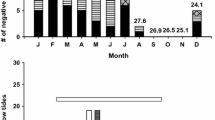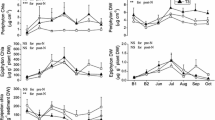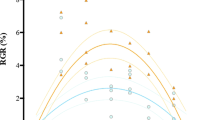Abstract
Understanding the photoacclimation response of macroalgae across broad spatial and temporal scales is necessary for predicting their vulnerability to environmental changes and quantifying their contribution to coastal primary production. This study investigated how the photosynthesis–irradiance response and photosynthetic pigment content of the kelp Ecklonia radiata varies both spatially and seasonally among seven sites located across a turbidity gradient in the Hauraki Gulf, north-eastern New Zealand. Photosynthesis–irradiance curves were derived under laboratory conditions for whole adult E. radiata using photorespirometry chambers. Lab-derived photosynthesis–irradiance curves in summer were also compared with in situ measurements made on kelp at each of the seven study sites. Photosynthetic parameters and pigments showed clear seasonal patterns across all sites as demonstrated by higher photosynthetic pigment levels and photosynthetic efficiency occurring in autumn and winter, and higher maximum rates of photosynthesis and respiration occurring in summer. Lamina biomass was similar across sites, yet thalli exhibited a clear photokinetic response to increasing turbidity. At turbid sites photosynthetic pigment levels and photosynthetic efficiency was higher, and respiration and saturation and compensation irradiances lower, compared to high-light sites. The results presented here further our understanding of low-light acclimation strategies in kelp and highlight the degree of seasonality in photosynthetic parameters. Though E. radiata demonstrates a clear capacity to photoacclimate to a degrading light environment, further research is needed to investigate the extent to which the observed acclimation can offset the likely negative effects of increasing turbidity on kelp forest primary production.






Similar content being viewed by others
References
Airoldi L, Beck MW (2007) Loss, status and trends for coastal marine habitats of Europe. In: Oceanography and marine biology: an annual review, vol 45. CRC Press, Boca Raton, pp 357–417
Airoldi L, Cinelli F (1997) Effects of sedimentation on subtidal macroalgal assemblages: an experimental study from a Mediterranean rocky shore. J Exp Mar Biol Ecol 215:269–288. https://doi.org/10.1016/s0022-0981(96)02770-0
Anthony K, Ridd PV, Orpin AR, Larcombe P, Lough J (2004) Temporal variation of light availability in coastal benthic habitats: effects of clouds, turbidity, and tides. Limnol Oceanogr 49(6):2201–2211. https://doi.org/10.4319/lo.2004.49.6.2201
Aumack CF, Dunton KH, Burd AB, Funk DW, Maffione RA (2007) Linking light attenuation and suspended sediment loading to benthic productivity within an arctic kelp-bed community. J Phychol 43(5):853–863. https://doi.org/10.1111/j.1529-8817.2007.00383.x
Barufi JB, Korbee N, Oliveira MC, Figueroa FL (2011) Effects of N supply on the accumulation of photosynthetic pigments and photoprotectors in Gracilaria tenuistipitata (Rhodophyta) cultured under UV radiation. J Appl Phycol 23:457–466. https://doi.org/10.1007/s10811-010-9603-x
Bearham D, Vanderklift MA, Gunson JR (2013) Temperature and light explain spatial variation in growth and productivity of the kelp Ecklonia radiata. Mar Ecol Prog Ser 476:59–70. https://doi.org/10.3354/meps10148
Bell TW, Cavanaugh KC, Reed DC, Siegel DA (2015) Geographical variability in the controls of giant kelp biomass dynamics. J Biogeogr 42(10):2010–2021. https://doi.org/10.1111/jbi.12550
Binzer T, Sand-Jensen K, Middelboe AL (2006) Community photosynthesis of aquatic macrophytes. Limnol Oceanogr 51(6):2722–2733. https://doi.org/10.4319/lo.2006.51.6.2722
Bruno JF, Bertness MD (2001) Habitat modification and facilitation in benthic marine communities. In: Bertness MD (ed) Marine community ecology. Sinauer Associates Inc., Sunderland, pp 119–125
Cabello-Pasini A, Aguirre-von-Wobeser E, Figueroa FL (2000) Photoinhibition of photosynthesis in Macrocystis pyrifera (Phaeophyceae), Chondrus crispus (Rhodophyceae) and Ulva lactuca (Chlorophyceae) in outdoor culture systems. J Photochem Photobiol B 57(2–3):169–178. https://doi.org/10.1016/S1011-1344(00)00095-6
Campbell S, Bité J, Burridge T (1999) Seasonal patterns in the photosynthetic capacity, tissue pigment and nutrient content of different developmental stages of Undaria pinnatifida (Phaeophyta: Laminariales) in Port Phillip Bay, south-eastern Australia. Bot Mar 42(3):231–242. https://doi.org/10.1515/BOT.1999.027
Cavanaugh KC, Siegel DA, Reed DC, Dennison PE (2011) Environmental controls of giant-kelp biomass in the Santa Barbara Channel, California. Mar Ecol Prog Ser 429:1–17. https://doi.org/10.3354/meps09141
Chapman ARO, Craigie JS (1977) Seasonal growth in Laminaria longicruris: relations with dissolved inorganic nutrients and internal reserves of nitrogen. Mar Biol 40:197–205. https://doi.org/10.1007/BF00390875
Chapman A, Craigie J (1978) Seasonal growth in Laminaria longicuris: relations with reserve carbohydrate storage and production. Mar Biol 46(3):209–213. https://doi.org/10.1007/BF00390682
Chapman A, Markham J, Lüning K (1978) Effects of nitrate concentration on the growth and physiology of Laminaria saccharina (Phaeophyta) in culture. J Phycol 14(2):195–198. https://doi.org/10.1111/j.1529-8817.1978.tb02448.x
Colombo-Pallotta MF, García-Mendoza E, Ladah LB (2006) Photosynthetic performance, light absorption, and pigment composition of Macrocystis pyrifera (Laminariales, Phaeophyceae) blades from different depths. J Phychol 42(6):1225–1234. https://doi.org/10.1111/j.1529-8817.2006.00287.x
Cruces E, Rautenberger R, Rojas-Lillo Y, Cubillos VM, Arancibia-Miranda N, Ramírez-Kushel E, Gómez I (2017) Physiological acclimation of Lessonia spicata to diurnal changing PAR and UV radiation: differential regulation among down-regulation of photochemistry, ROS scavenging activity and phlorotannins as major photoprotective mechanisms. Photosynth Res 131(2):145–157. https://doi.org/10.1007/s11120-016-0304-4
Cullen JJ, Davis RF, Huot Y (2012) Spectral model of depth-integrated water column photosynthesis and its inhibition by ultraviolet radiation. Global Biogeochem Cycles. https://doi.org/10.1029/2010GB003914
Davies-Colley RJ, Smith DG (2001) Turbidity, suspended sediment, and water clarity: a review. J Am Water Resour Assoc 37:1085–1101
Davison IR (1987) Adaptation of photosynthesis in Laminaria saccharina (Phaeophyta) to changes in growth temperature. J Phychol 23(2):273–283
Davison IR (1991) Environmental effects on algal photosynthesis: temperature. J Phycol 27:2–8. https://doi.org/10.1111/j.0022-3646.1991.00002.x
Davison I, Greene R, Podolak E (1991) Temperature acclimation of respiration and photosynthesis in the brown alga Laminaria saccharina. Mar Biol 110(3):449–454. https://doi.org/10.1007/BF01344363
Dayton PK (1985) Ecology of kelp communities. Annu Rev Ecol Syst 16:215–245
Delebecq G, Davoult D, Menu D, Janquin M-A, Dauvin J-C, Gevaert F (2013) Influence of local environmental conditions on the seasonal acclimation process and the daily integrated production rates of Laminaria digitata (Phaeophyta) in the English Channel. Mar Biol 160(3):503–517. https://doi.org/10.1007/s00227-012-2106-3
Delebecq G, Davoult D, Janquin M-A, Oppliger LV, Menu D, Dauvin J-C, Gevaert F (2016) Photosynthetic response to light and temperature in Laminaria digitata gametophytes from two French populations. Eur J Phycol 51(1):71–82. https://doi.org/10.1080/09670262.2015.1104556
Desmond MJ, Pritchard DW, Hepburn CD (2015) Light limitation within southern New Zealand kelp forest communities. PLoS ONE. https://doi.org/10.1371/journal.pone.0123676
Dromgoole F (1988) Light fluctuations and the photosynthesis of marine algae. II. Photosynthetic response to frequency, phase ratio and amplitude. Funct Ecol 1:211–219. https://doi.org/10.2307/2389697
Edwards MS, Kim KY (2010) Diurnal variation in relative photosynthetic performance in giant kelp Macrocystis pyrifera (Phaeophyceae, Laminariales) at different depths as estimated using PAM fluorometry. Aquat Bot 92(2):119–128. https://doi.org/10.1016/j.aquabot.2009.10.017
Enríquez S, Duarte CM, Sand-Jensen K, Nielsen SL (1996) Broad-scale comparison of photosynthetic rates across phototrophic organisms. Oecologia 108(2):197–206. https://doi.org/10.1007/BF00334642
Fairhead VA, Cheshire AC (2004a) Rates of primary productivity and growth in Ecklonia radiata measured at different depths, over an annual cycle, at West Island, South Australia. Mar Biol 145:41–50. https://doi.org/10.1007/s00227-004-1308-8
Fairhead VA, Cheshire AC (2004b) Seasonal and depth related variation in the photosynthesis–irradiance response of Ecklonia radiata (Phaeophyta, Laminariales) at West Island, South Australia. Mar Biol 145(2):415–426. https://doi.org/10.1007/s00227-0041330-x
Falkowski PG, LaRoche J (1991) Acclimation to spectral irradiance in algae. J Phycol 27:8–14. https://doi.org/10.1111/j.0022-3646.1991.00008.x
Falkowski PG, Owens TG (1980) Light—shade adaptation two strategies in marine phytoplankton. Plant Physiol 66(4):592–595
Falkowski PG, Raven JA (2007) Aquatic photosynthesis, 2nd edn. Princeton University Press, Princeton
Falkowski PG, Owens TG, Ley AC, Mauzerall DC (1981) Effects of growth irradiance levels on the ratio of reaction centers in two species of marine phytoplankton. Plant Physiol 68(4):969–973. https://doi.org/10.1104/pp.68.4.969
Fork DC, Murata N, Sato N (1979) Effect of growth temperature on the lipid and fatty acid composition, and the dependence on temperature of light-induced redox reactions of cytochrome f and of light energy redistribution in the thermophilic blue-green alga Synechococcus lividus. Plant Physiol 63(3):524–530. https://doi.org/10.1104/pp.63.3.524
Franklin LA, Forster RM (1997) The changing irradiance environment: consequences for marine macrophyte physiology, productivity and ecology. Eur J Phycol 32:207–232. https://doi.org/10.1080/09670269710001737149
Gerard VA (1982) In situ rates of nitrate uptake by giant kelp, Macrocystis pyrifera (L.) C. Agardh: tissue differences, environmental effects, and predictions of nitrogen-limited growth. J Exp Mar Biol Ecol 62(3):211–224. https://doi.org/10.1016/0022-0981(82)90202-7
Gerard V (1988) Ecotypic differentiation in light-related traits of the kelp Laminaria saccharina. Mar Biol 97(1):25–36. https://doi.org/10.1007/BF00391242
Gerard V, Du Bois K (1988) Temperature ecotypes near the southern boundary of the kelp Laminaria saccharina. Mar Biol 97(4):575–580. https://doi.org/10.1007/BF00391054
Gevaert F, Creach A, Davoult D, Holl AC, Seuront L, Lemoine Y (2002) Photo-inhibition and seasonal photosynthetic performance of the seaweed Laminaria saccharina during a simulated tidal cycle: chlorophyll fluorescence measurements and pigment analysis. Plant Cell Environ 25(7):859–872. https://doi.org/10.1046/j.1365-3040.2002.00869.x
Goff JR (1997) A chronology of natural and anthropogenic influences on coastal sedimentation, New Zealand. Mar Geol 138(1–2):105–117. https://doi.org/10.1016/S0025-3227(97)00018-2
Gomez I, Weykam G, Klöser H, Wiencke C (1997) Photosynthetic light requirements, metabolic carbon balance and zonation of sublittoral macroalgae from King George Island (Antarctica). Mar Ecol Prog Ser 148:281–293. https://doi.org/10.3354/meps148281
Häder D, Figueroa FL (1997) Photoecophysiology of marine macroalgae. Photochem Photobiol 66(1):1–14. https://doi.org/10.1111/j.1751-1097.1997.tb03132.x
Harley CD, Anderson KM, Demes KW, Jorve JP, Kordas RL, Coyle TA, Graham MH (2012) Effects of climate change on global seaweed communities. J Phycol 48:1064–1078. https://doi.org/10.1111/j.1529-8817.2012.01224.x
Hayward BW, Grenfell HR, Sabaa AT, Morley MS, Horrocks M (2006) Effect and timing of increased freshwater runoff into sheltered harbour environments around Auckland City, New Zealand. Estuar Coast 29(2):165–182. https://doi.org/10.1007/BF02781987
Heinrich S, Valentin K, Frickenhaus S, John U, Wiencke C (2012) Transcriptomic analysis of acclimation to temperature and light stress in Saccharina latissima (Phaeophyceae). PLoS ONE 7(8):e44342. https://doi.org/10.1371/journal.pone.0044342
Hepburn CD, Pritchard DW, Cornwall CE, McCleod RJ, Beardall J, Raven JA, Hurd CL (2011) Diversity of carbon use strategies in a kelp forest community: implications for a high CO2 ocean. Glob Change Biol 17:2488–2497. https://doi.org/10.1111/j.1365-2486.2011.02411.x
Huovinen P, Gómez I (2013) Photosynthetic characteristics and UV stress tolerance of Antarctic seaweeds along the depth gradient. Polar Biol 36:1319–1332. https://doi.org/10.1007/s00300-013-1351-3
Kain JM (1979) A view of the genus Laminaria. Oceanogr Mar Biol Annu Rev 17:101–161
Kavanaugh MT, Nielsen KJ, Chan FT, Menge BA, Letelier RM, Goodrich LM (2009) Experimental assessment of the effects of shade on an intertidal kelp: do phytoplankton blooms inhibit growth of open coast macroalgae? Limnol Oceanogr 54(1):276–288. https://doi.org/10.4319/lo.2009.54.1.0276
King R, Schramm W (1976) Photosynthetic rates of benthic marine algae in relation to light intensity and seasonal variations. Mar Biol 37(3):215–222. https://doi.org/10.1007/BF00387606
Kirk JTO (1985) Effects of suspensoids (turbidity) on penetration of solar radiation in aquatic ecosystems. Hydrobiologia 125:195–208. https://doi.org/10.1007/BF00045935
Kirk JTO (2011) Light and photosynthesis in aquatic ecosystems, 3rd edn. Cambridge University Press, Cambridge
Kirkman H (1984) Standing stock and production of Ecklonia radiata (C. Ag.): J. Agardh. J Exp Mar Biol Ecol 76:119–130. https://doi.org/10.1016/0022-0981(84)90060-1
Kirkman H (1989) Growth, density and biomass of Ecklonia radiata at different depths and growth under artificial shading off Perth, Western Australia. Mar Freshw Res 40:169–177. https://doi.org/10.1071/MF9890169
Koch K, Thiel M, Hagen W, Graeve M, Gómez I, Jofre D, Hofmann LC, Tala F, Bischof K (2016) Short-and long-term acclimation patterns of the giant kelp Macrocystis pyrifera (Laminariales, Phaeophyceae) along a depth gradient. J Phycol 52(2):260–273. https://doi.org/10.1111/jpy.12394
Krumhansl KA, Okamoto DK, Rassweiler A, Novak M, Bolton JJ, Cavanaugh KC, Connell SD, Johnson CR, Konar B, Ling SD (2016) Global patterns of kelp forest change over the past half-century. Proc Natl Acad Sci 113(48):13785–13790. https://doi.org/10.3354/ab00366
Kuebler JE, Davison IR, Yarish C (1991) Photosynthetic adaptation to temperature in the red algae Lomentaria baileyana and Lomentaria orcadensis. Br Phycol J 26(1):9–19. https://doi.org/10.1080/00071619100650021
Küppers U, Weidner M (1980) Seasonal variation of enzyme activities in Laminaria hyperborea. Planta 148(3):222–230. https://doi.org/10.1007/BF00380031
Larkum AWD (1986) A study of growth and primary production in Ecklonia radiata (C. Ag.) J. Agardh (Laminariales) at a sheltered site in Port Jackson, New South Wales. J Exp Mar Biol Ecol 96:117–190. https://doi.org/10.1016/0022-0981(86)90241-8
Machalek K, Davison I, Falkowski P (1996) Thermal acclimation and photoacclimation of photosynthesis in the brown alga Laminaria saccharina. Plant Cell Environ 19(9):1005–1016. https://doi.org/10.1111/j.1365-3040.1996.tb00207.x
Mann KH (1973) Seaweeds: their productivity and strategy for growth. Science 182:975–981
Marambio J, Rodriguez J, Mendez F, Ocaranza P, Rosenfeld S, Ojeda J, Rautenberger R, Bischof K, Terrados J, Mansilla A (2017) Photosynthetic performance and pigment composition of Macrocystis pyrifera (Laminariales, Phaeophyceae) along a gradient of depth and seasonality in the ecoregion of Magellan, Chile. J Appl Phycol 29(5):2575–2585. https://doi.org/10.1007/s10811-017-1136-0
Markager S, Sand-Jensen K (1992) Light requirements and depth zonation of marine macroalgae. Mar Ecol Prog Ser 88:83–83
Miller RJ, Reed DC, Brzezinski MA (2011a) Partitioning of primary production among giant kelp (Macrocystis pyrifera), understory macroalgae, and phytoplankton on a temperate reef. Limnol Oceanogr 56:119–132
Miller SM, Hurd CL, Wing SR (2011b) Variations in growth, erosion, productivity, and morphology of Ecklonia radiata (Alariaceae; Laminariales) along a fjord in sourthern New Zealand. J Phycol 47:505–516. https://doi.org/10.1111/j.1529-8817.2011.00966.x
Miller RJ, Harrer S, Reed D (2012) Addition of species abundance and performance predicts community primary production of macroalgae. Oecologia 168:797–806. https://doi.org/10.1007/s00442-011-2143-5
Novaczek I (1984) Development and phenology of Ecklonia radiata at two depths in Goat Island Bay, New Zealand. Mar Biol 81:189–197. https://doi.org/10.1007/BF00393117
Prézelin BB (1976) The role of peridinin-chlorophyll a-proteins in the photosynthetic light adaption of the marine dinoflagellate, Glenodinium sp. Planta 130(3):225–233. https://doi.org/10.1007/BF00387826
Raven JA, Geider RJ (2003) Adaptation, acclimation and regulation in algal photosynthesis. In: Photosynthesis in algae. Springer, Berlin, pp 385–412. https://doi.org/10.1007/978-94-007-1038-2_17
Rodgers KL, Shears NT (2016) Modelling kelp forest primary production using in situ photosynthesis, biomass and light measurements. Mar Ecol Prog Ser 553:67–79. https://doi.org/10.3354/meps11801
Rodgers KL, Rees TAV, Shears NT (2015) A novel system for measuring in situ rates of photosynthesis and respiration of kelp. Mar Ecol Prog Ser 528:101–115. https://doi.org/10.3354/meps11273
Rodrigues MA, Dos Santos CP, Yoneshigue-Valentin Y, Strbac D, Hall DO (2000) Photosynthetic light-response curves and photoinhibition of the deep-water Laminaria abyssalis and the intertidal Laminaria digitata (Phaeophyceae). J Phycol 36(1):97–106. https://doi.org/10.1046/j.1529-8817.2000.98213.x
Roleda MY, Dethleff D, Wienke C (2008) Transient sediment load on blades of arctic Saccharina latissima can mitigate UV radiation effect on photosynthesis. Polar Biol 31:765–769. https://doi.org/10.1007/s00300-008-0434-z
Sakanishi Y, Yokohama Y, Aruga Y (1989) Seasonal changes of photosynthetic activity of a brown alga Ecklonia cava Kjellman. J Plant Res 102(1):37–51. https://doi.org/10.1007/BF02488111
Schiel DR, Foster MS (1986) The structure of subtidal algal stands in temperate waters. Oceanogr Mar Biol Annu Rev 24:265–307
Schreiber U (2004) Pulse-amplitude-modulation (PAM) fluorometry and saturation pulse method: an overview. In: Chlorophyll a fluorescence. Springer, Dordrecht, pp 279–319
Seely G, Duncan M, Vidaver W (1972) Preparative and analytical extraction of pigments from brown algae with dimethyl sulfoxide. Mar Biol 12(2):184–188. https://doi.org/10.1007/BF00350754
Seers BM, Shears NT (2015) Spatio-temporal patterns in coastal turbidity—long-term trends and drivers of variation across an estuarine-open coast gradient. Estuar Coast Shelf Sci 154:137–151. https://doi.org/10.1016/j.ecss.2014.12.018
Shepherd SA, Watson JE, Womersley HBS, Carey JM (2009) Long-term changes in macroalgal assemblages after increased sedimentation and turbidity in Western Port, Victoria, Australia. Bot Mar 52:195–206. https://doi.org/10.1515/BOT.2009.036
Shivji MS (1985) Interactive effects of light and nitrogen on growth and chemical composition of juvenile Macrocystis pyrifera (L.). C. Ag. (Phaeophyta) sporophytes. J Exp Mar Biol Ecol 89(1):81–96. https://doi.org/10.1016/0022-0981(85)90083-8
Smith VH, Schindler DW (2009) Eutrophication science: where do we go from here? Trends Ecol Evol 24(4):201–207. https://doi.org/10.1016/j.tree.2008.11.009
Smith RG, Wheeler WN, Srivastava LM (1983) Seasonal photosynthetic performance of Macrocystis integrifolia (Phaeophyceae). J Phychol 19(3):352–359
Snedecor GW, Cochran WG (1989) Statistical methods. Iowa State University Press, Ames
Staehr PA, Wernberg T (2009) Physiological responses of Ecklonia radiata (Laminariales) to a latitudinal gradient in ocean temperature. J Phychol 45:91–99
Steneck RS, Graham MH, Bourque BJ, Corbett D, Erlandson JM, Estes JA, Tegner MJ (2002) Kelp forest ecosystems: biodiversity, stability, resilience and future. Environ Conserv 29(4):436–459. https://doi.org/10.1017/S0376892902000322
Sukenik A, Bennett J, Falkowski P (1987) Light-saturated photosynthesis—limitation by electron transport or carbon fixation? Biochim et Biophys Acta (BBA)-Bioenerg 891(3):205–215. https://doi.org/10.1016/0005-2728(87)90216-7
Tait LW, Schiel DR (2010) Primary productivity of intertidal macroalgal assemblages: comparison of laboratory and in situ photorespirometry. Mar Ecol Prog Ser 416:115–125. https://doi.org/10.3354/meps08781
Tait LW, Hawes I, Schiel DR (2017) Integration of chlorophyll a fluorescence and photorespirometry techniques to understand production dynamics in macroaglal communities. J Phycol 53(3):476–485. https://doi.org/10.1111/jpy.12524
Talarico L, Maranzana G (2000) Light and adaptive responses in red macroalgae: an overview. J Photochem Photobiol B 56:1–11. https://doi.org/10.1016/S1011-1344(00)00046-4
Turpin DH (1991) Effects of inorganic N availability on algal photosynthesis and carbon metabolism. J Phychol 27(1):14–20. https://doi.org/10.1111/j.0022-3646.1991.00014.x
Webb WL, Newton M, Starr D (1974) Carbon dioxide exchange of Alnus rubra. Oecologia 17:281–291. https://doi.org/10.1007/BF00345747
Wernberg T, Goldberg N (2008) Short-term temporal dynamics of algal species in a subtidal kelp bed in relation to changes in environmental conditions and canopy biomass. Estuar Coast Shelf Sci 76(2):265–272. https://doi.org/10.1016/j.ecss.2007.07.008
Wheeler W (1980) Pigment content and photosynthetic rate of the fronds of Macrocystis pyrifera. Mar Biol 56(2):97–102. https://doi.org/10.1007/BF00397127
Wing SR, Patterson MR (1993) Effects of wave-induced lightflecks in the intertidal zone on photosynthesis in the macroalgae Postelsia palmaeformis and Hedophyllum sessile (Phaeophyceae). Mar Biol 116(3):519–525. https://doi.org/10.1007/BF00350069
Acknowledgements
We thank S. C. Hansen, A. Spyksma, S. Kulins, N. Goebeler, J. Hamilton, and H. Allard for field assistance; P. Browne, E. Murray and J. Atkins for technical assistance; B. Seers for assistance with R coding; T.A.V. Rees for valuable discussion on photosynthesis measurements. Funding was provided by a Royal Society of New Zealand Rutherford Discovery Fellowship to N.T.S. and a University of Auckland Doctoral Scholarship to C.O.B.
Funding
This study was funded by a Royal Society of New Zealand Rutherford Discovery Fellowship (Grant No. RDF-UOA1103) to N.T.S.
Author information
Authors and Affiliations
Corresponding author
Ethics declarations
Conflict of interest
The authors declare that they have no conflict of interest.
Additional information
Publisher’s Note
Springer Nature remains neutral with regard to jurisdictional claims in published maps and institutional affiliations.
Electronic Supplementary Material
Below is the link to the electronic supplementary material.
Rights and permissions
About this article
Cite this article
Blain, C.O., Shears, N.T. Seasonal and spatial variation in photosynthetic response of the kelp Ecklonia radiata across a turbidity gradient. Photosynth Res 140, 21–38 (2019). https://doi.org/10.1007/s11120-019-00636-7
Received:
Accepted:
Published:
Issue Date:
DOI: https://doi.org/10.1007/s11120-019-00636-7




